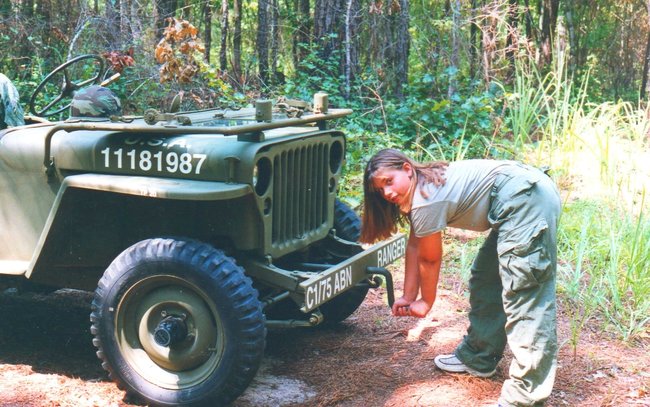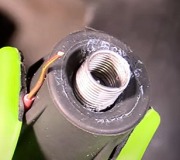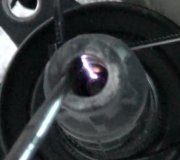To be sure the terminology is not confusing me, coil packs are used when there is no distributor. The most popular GM HEI distributor had a single ignition coil mounted on the top of the distributor cap. Is that what you have? If you do, there are some common problems to consider. The first one has to do with checking for spark. These ignition coils are capable of developing well over 40,000 volts. It's important to understand that a coil will only develop the voltage it takes to jump the spark plug's gap. Once the spark occurs and current is flowing, no additional voltage will be developed. The problem comes in when checking for spark if you pull the spark plug or wire too far from the engine. Doing so increases the amount of voltage it takes to jump the gap. With the capability of developing over 40,000 volts, that spark is going to jump somewhere, and when the gap at the plug is too big, it arcs through the rotor in the distributor to the metal shaft it sits on. An arc leaves a carbon track behind and carbon is a conductor of electrical current, so the spark current from then on is shorted to the distributor shaft. That is called "punch-through". The rotor is actually shorted, but since carbon is not the best of conductors, it is possible to get an intermittent spark at a spark plug if jumping that gap is easier than jumping to the distributor shaft. Current flow always takes the path of least resistance.
There is a carbon button under the distributor cap that contacts the metal part on the rotor. That carbon breaks off and forms a powder on the rotor which also can promote spark jumping to the wrong place. If you have had the cap off a few times, watch that the carbon button does not fall out. You actually have to install that button yourself with some replacement caps.
We used to check for spark at the coil wire going to the distributor, but that is hidden inside this distributor. If you look at which terminal the rotor tip is pointing to, then reinstall the cap and go to that spark plug wire, watch there for a single spark each time a helper turns the ignition switch off. If you get that consistently, suspect a shorted module. Normally a spark is generated each time the module, (or breaker points on older cars), turns off. When the module is shorted, it can't turn off, but turning the ignition switch off does the same thing. Either one interrupts current flow through the ignition coil, then a spark is generated.
Another common problem was an open circuit in the pickup coil. In later versions that coil was stationary. It triggered a seriously-advanced spark timing, then its trigger pulse went to a computer that calculated the desired amount of delay before it triggered the ignition module to trigger the ignition coil. That was how they adjusted ignition timing for changes in engine speed and load. If you have a vacuum advance unit on your distributor, timing advance is handled the same way it was with breaker points. That was to shift the plate the points, (pick-up coil in your case), sits on. That shifting back and forth eventually caused the wires to break off the pick-up coil. The solder connections for those wires were known to corrode too. Either condition could cause a crank / no-start condition which could be intermittent, and it could commonly occur only after a hot engine had been turned off for a few minutes. The engine heat created "hot soak", meaning the heat that normally blew away from natural air flow, migrated up to the pick-up coil where the heat cause the wires to expand and break the connection. They often worked again after cooling down for an hour.
GM has history of designing assemblies that need to be replaced as such. It is always up to the aftermarket industry to make individual replacement parts available as well as the tools to get some of these assemblies apart. Their "SI" generators with built-in voltage regulator, and their HEI distributor with built-in ignition coil and module are two examples. This is a bad deal for owners when just one part has failed, like the voltage regulator, because you end up buying many more parts than are needed when you buy the whole assembly. The advantage to this is very little diagnostic time is needed. Also, when the HEI system was introduced in 1976, no one understood the theory or how to diagnose and repair them. All no-spark problems were solved by simply dropping in a new distributor and connecting the one red wire. This was a good way to insure elusive intermittent problems were solved too. You might want to consider this too. The cost of a used or rebuilt distributor can be a lot less than the time to find the cause of the problem if you consider your time to be valuable. First be sure you have 12 volts on that red wire when the ignition switch is in the "run" position. If you have 12 volts and a new distributor but still have no spark, the distributor shaft is most likely not turning due to a broken timing chain or teeth stripped off the camshaft sprocket. Neither of those are very common.
As a point of interest, you can make this distributor generate a spark without installing it in the engine, but you have to be careful about that punch-through. You need to connect the terminal for the red wire to the battery positive terminal, then another jumper wire from the vehicle's ground to a metal part of the distributor housing. At this point you will get spark from each spark plug wire terminal when you spin the shaft by hand. You need to connect the plastic ring with the spark plug wires, and anchor those wires close to ground, or connect six jumper wires so they are close to ground. Now spin the shaft and you will see spark jumping from each spark plug wire. This should not be a display you show to all the kids in the neighborhood. This is done just enough to verify this is a working distributor. Every time a spark jumps from a terminal to ground, it leaves a tiny trail of carbon on the inside of the spark plug boot. That carbon can become a conductor that is able to make the spark bypass the spark plug. Once that starts, it takes hold and continues to burn the boot away. Of course there will be misfire too.
Monday, September 19th, 2016 AT 4:17 PM





